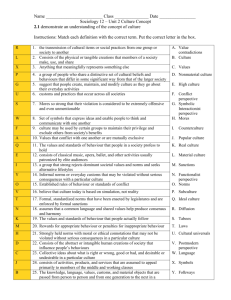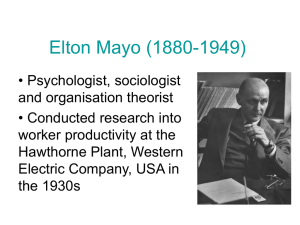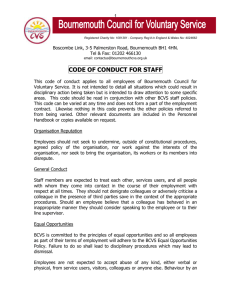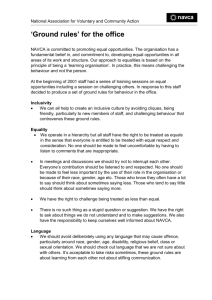Human Relations Approach to Management
advertisement
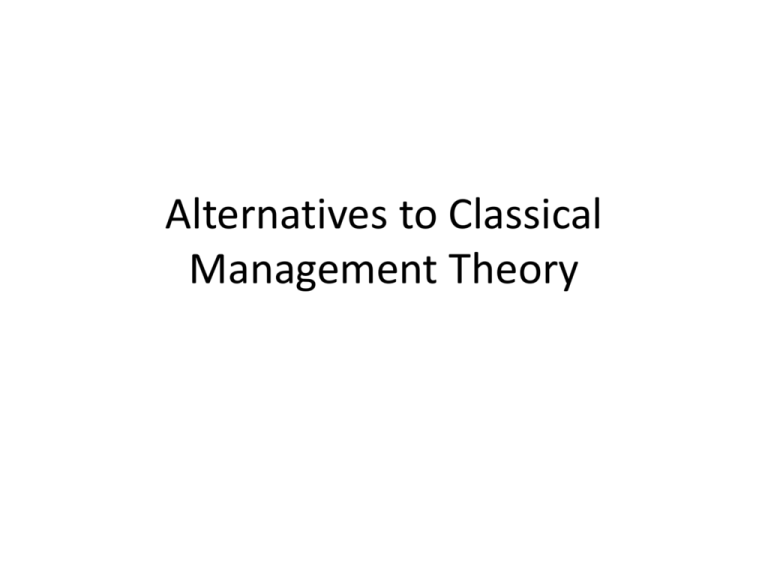
Alternatives to Classical Management Theory Objectives To explore theories of management which offer an alternative view to the Classical Management theories: – – – – Human relations theory Neo-relations theory Systems approach Contingency approach Main approaches to organisation, structure and management Main approaches to organisation, structure and management Taylor’s legacy • Work study systems • Payment by results • Management by exception – operate within your delegated role • Production control – e.g. the assembly line and Fordism • Systematic and procedural training Four main features of bureaucracy • Specialisation • Hierarchy of authority • System of rules • Impersonal behaviour Stewart. The Human Relations Approach • The main emphasis in classical management theory: – Structure – Formal organisation • Human Relations school of thought: – Social factors at work – Behaviour of employees Elton Mayo 1880-1949 • He was interested in: – – – – Motivation Commitment Human emotion Worker management relations Elton Mayo • He highlighted the importance of communication between management and workers and for managers to show respect to their staff • He identified that work satisfaction lay in recognition, security and a sense of belonging rather than monetary rewards Hawthorne studies 1924-1932 4 phases to the experiment: 1. 2. 3. 4. The illumination experiments The relay assembly test room The interviewing programme The bank wiring observations room Illumination experiments • Experimented with intensity of lighting on production • Workers were split into 2 groups – Experimental group – Control group • Results were inconclusive Conclusions • Production rates were variable in both groups • Production actually increased when conditions were made worse or remained the same • Production was influenced by factors other than changes in physical conditions Relay assembly test room • • • • Work was boring and repetitive Segregated a group of 6 women Over a 5 year period Altered their conditions of work: – – – – New payment systems Rest breaks of different sorts and length Varying length of working day Offered food and refreshments Relay assembly test room • In almost all cases productivity improved • Mayo felt he had proved his point • Returned the women to their original conditions – 6 day week – Long hours – No rest breaks or refreshments • Productivity rose to its highest level!!! Conclusions • Women felt important because they had been singled out • Developed good relationships with each other and this allowed for better working conditions • Allowed to set their own work patterns • Observer consulted the women, listened to their complaints and kept them informed about the experiment • Interest shown by management Mayo’s conclusion • That satisfaction must depend to a large extent on informal social relationships – In the group – Between workers and their managers • Satisfaction at work influences production The interviewing programme • 20,000 interviews conducted • Set of prepared questions on workers feelings towards: – Supervision – General conditions at work • However, workers wanted to talk about other conditions • Interviewers changed their style to non-directive, open questions • Workers true feelings and attitudes were analysed Bank wiring observation room • 14 men observed • Piece rate • Formed their own informal relationships, sub groups, norms of what constituted ‘proper’ behaviour • Despite financial incentive, the group decided on a level of output lower than they were capable of producing Conclusions • Group pressures on individual workers were stronger than financial incentives offered by management • The group thought that if they increased production, the management would raise the standard level of piece rate Criticisms • Methodology – Women – relay assembly test room (ouput increased) – Men – bank wiring room (output restricted) • Sex power differential – women were used to working for male supervisors and readily agreed to participate with management in the experiement Benefits of the research • One of the most important social science investigations into ‘humanising’ work • Emphasised the importance of: – The ‘informal’ organisation – Wider social needs – Group values and norms, in influencing behaviour at work Benefits of the research • One of the most important social science investigations into ‘humanising’ work • Emphasised the importance of: – The ‘informal’ organisation – Wider social needs – Group values and norms, in influencing behaviour at work Activity As a group that formed approximately 12 months ago, can you identify what this group’s norms and values are and how do they affect the way you work?
